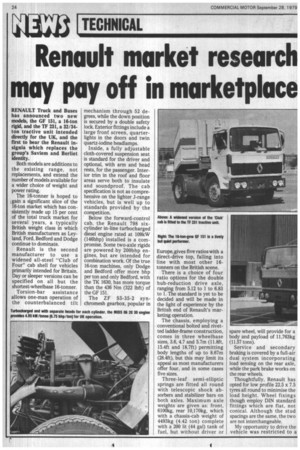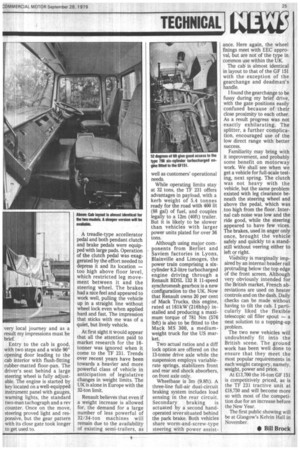Renault market research may pay off in marketplace
Page 26

Page 27

If you've noticed an error in this article please click here to report it so we can fix it.
RENAULT Truck and Buses has announced two new models, the GF 151, a 16-ton rigid, and the TF 231, a 32/34ton tractive unit intended directly for the UK, and the first to bear the Renault insignia which replaces the group's Saviem and Berliet identity.
Both models are additions to the existing range, not replacements, and extend the number of models available for a wider choice of weight and power rating.
The 16-tonner is hoped to gain a significant slice of the 16-ton market which has consistently made up 15 per cent of the total truck market for several years, a typically British weight class in which British manufacturers as Leyland, Ford, Bedford and Dodge continue to dominate.
Renault is the second manufacturer to use a widened all-steel "Club of Four" cab shell for vehicles primarily intended for Britain. Day or sleeper versions can be specified on all but the shortest-wheelbase 16-tonner.
Torsion-bar assistance allows one-man operation of the counterbalanced tilt mechanism through 52 de grees, while the down position is secured by a double safety lock. Exterior fittings include a large front screen, quarterlights in the doors and twin quartz-iodine headlamps.
Inside, a fully adjustable cloth-covered suspension seat is standard for the driver and optional, with arm and head rests, for the passenger. Inter ior trim in the roof and floor areas serve both to insulate and soundproof. The cab specification is not as comprehensive on the lighter J-range vehicles, but is well up to standards provided by the competition.
Below the forward-control cab, the Renault 798 six cylinder in-line turbocharged diesel engine rated at 109kW (146bhp) installed is a com promise. Some two-axle rigids are powered by 200bhp engines, but are intended for combination work. Of the true 16-ton machines, only Dodge and Bedford offer more bhp per ton and only Bedford, with the TK 1630, has more torque than the 436 Nm (322 lbft) of the GF 151.
The ZF 55-35-2 synchromesh gearbox, popular in Europe, gives five.ratios with a direct-drive top, falling into line with most other 16tonners on the British scene.
There is a choice of four ratio options for the double hub-reduction drive axle, ranging from 5.12 to 1 to 6.83 to 1. The standard is yet to be decided and will be made in the light of experience by the British end of Renault's marketing operation.
The chassis, employing a conventional bolted and rivetted ladder-frame construction, comes in three wheelbase sizes, 3.6, 4.7 and 5.7m (11.8ft, 15.4ft and 18.7ft) permitting body lengths of up to 8.67m (28.4ft), but this may limit its appeal as most manufacturers offer four, and in some case.s five sizes.
Three-leaf semi-elliptic springs are fitted all round with telescopic shock absorbers and stabilizer bars on both axles. Maximum axle weights are given as: front, 6100kg, rear 10,170kg, which with a chassis-cab weight of 4493kg (4.42 ton) complete with a 200 lit (44 gal) tank of fuel, but without driver or spare wheel, will provide for a body and payload of 11,763kg (11.57 tons), Service and secondary braking is covered by a full-air dual system incorporating load sensing on the rear axle, while the park brake works on the rear wheels.
Thoughtfully, Renault has opted for low profile 22.5 x 7.5 tyres all round to minimise the load height. Wheel fixings though employ DIN standard fittings which are flat, not conical. Although the stud spacings are the same, the two are not interchangeable.
My opportunity to drive the vehicle was restricted to a very local journey and as a result my impressions must be brief.
Entry to the cab is good, with two steps and a wide 900 opening door leading to the cab interior with flush-fitting rubber-matted floor-pan. The driver's seat behind a large steering wheel is fully adjustable. The engine is started by key located on a well-equipped instrument panel with gauges, warning lights, the standard two-man tachograph and a rev counter. Once on the move, steering proved light and responsive, but the gear pattern with its close gate took longer to get used to. A treadle-type accellerator pedal and both pendant clutch and brake pedals were equipped with large pads. Operation of the clutch pedal was exaggerated by the effort needed to depress it and its location — too high above floor level, which restricted leg movement between it and the steering wheel. The brakes had a nice feel and appeared to work well, pulling the vehicle up in a straight line without wheel lock even when applied hard and fast. The impression that sticks with me was of a quiet, but lively vehicle.
At first sight it would appear that all the attention paid to market research for the 16tonner was ignored when it come to the TF 231. Trends over recent years have been towards a heavier and more powerful class of vehicle in anticipation of legislative changes in weight limits. The UK is alone in Europe with the 32-ton limit.
Renault believes that even if a weight increase is allowed for, the demand for a large number of less powerful of 32/34-ton machines will remain due to the availability of existing semi-trailers, as well as customers' operational needs.
While operating limits stay at 32 tons, the TF 231 offers advantages in payload, with a kerb weight of 5.4 tonnes ready for the road with 400 lit (88 gal) of fuel, and couples legally to a 12m (40ft) trailer. But it is likely to be slower than vehicles with larger power units plated for over 36 tons.
Although using major components from Berliet and Saviem factories in Lyons, Blainville and Limoges, the power train comprising a sixcylinder 8.2-litre turbocharged engine driving through a Renault BDSL 132 R 11-speed synchromesh gearbox is a new configuration to the UK. Now that Renault owns 20 per cent of Mack Trucks, this engine, rated at 161kW (216bhp) installed and producing a maximum torque of 781 Nm (576 lbft) is also to be fitted to the Mack MS 300, a mediumweight truck for the US market.
Two actual ratios and a diff lock option are offered on the 13-tonne drive axle while the suspension employs variablerate springs, stabilizers front and rear and shock absorbers, on front axle only.
Wheelbase is 3m (9.8ft). A three-line full-air dual-circuit braking system includes load sensing in the rear circuit. Secondary braking is actuated by a second handoperated leversituated behind the park brake. Both vehicles share worm-and-screw-type steering with power assist ance. Here again, the wheel fixings meet with EEC approval, but are not of the type in common use within the UK.
The cab is almost identical in layout to that of the GF 151 with the exception of the gearchange and deadman's handle.
I found the gearchange to be fussy during my brief drive, with the gate positions easily confused because of their close proximity to each other.
As a result progress was not exactly exhilarating. The splitter, a further complica tion, encouraged use of the low direct range with better success.
Familiarity may bring with it improvement, and probably some benefit on motorway work. We shall see when we get a vehicle for full-scale testing, next spring. The clutch was not heavy with the vehicle, but the same problem existed with leg clearance beneath the steering wheel and above the pedal, which was too high from the floor. Internal cab noise was low and the ride good, while the steering appeared to have few vices. The brakes, used in anger only once, brought the vehicle safely and quickly to a standstill without veering either to left or right.
Visibility is marginally impaired by an internal header rail protruding below the top edge of the front screen. Although very obviously intended for the British market, French abreviations are used on heater controls and on the dash. Daily checks can be made without having to tilt the cab. I particularly liked the flexible telescopic oil filler spout — a neat solution to a topping-up problem.
The two new vehicles will undoubtedly fit into the British scene. The ground work has been well done to ensure that they meet the most popular requirements in each weight category, namely, weight, power and price.
At £13,700 the I6-ton GF 151 is competitively priced, as is the TF 231 tractive unit at £18,750 and will become more so with most of the competition due for an increase before the New Year.
The first public showing will be at Glasgow's Kelvin Hall in November.
• Bill Brock




























































































































































